1756
TWO BRIDGES INSTEAD OF FORDS IN ELLARS. – Bulding of the two bridges over Skelton Beck at Skelton Ellars.
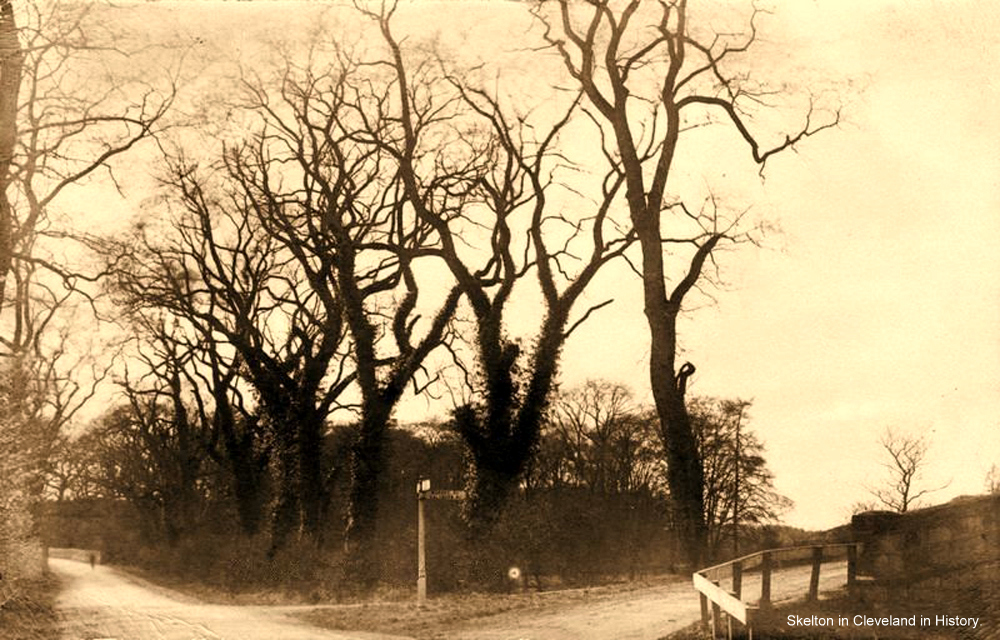
Skelton Ellers.
Prior to 1756, Skelton Beck had to be crossed by fords on the road ahead to Guisborough and on the Right to Upleatham.
Among the willows on the Left side of the road stood a basket maker’s cottage. It was still there in the early 1900’s
On the 22nd October 1884 Squire John Thomas Wharton was attacked right at this spot by a violent tramp and rescued by the basket maker.
This was also the scene of the murder of Dan Chilvers in 1909. See – Murder in the beck.
When the age of motoring and cycling came along, the steep hill and sharp bends, just behind, were the cause of many accidents.
1757
CORN SHORTAGE –
This was a time when ‘at present no exportation was allowed from the kingdom.’
Ralph Jackson’s journal records:-
“I walked up town [Guisborough] and saw several women and men…carrying three horse load of corn to the Towl Booth which they had seized from a man as Thomas Dales, as he was carrying to Tobias Tayler of Skelton for seed as they pretended, tho I find this Tayler…is charged with shipping corn clandestinely on board smugglers.”
1759
JOHN WESLEY –
preaches in Guisborough for the first time. It is said he also visited Skelton ‘several times’, but no proof exists.
1760
DEATH OF GEORGE II –
The death of George II and the accession of George III.
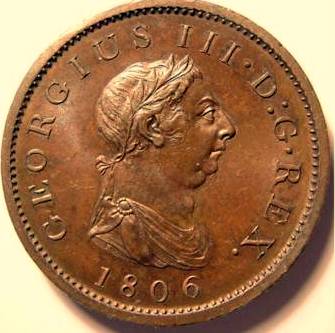
George III Penny.
NEW PARSON – The new Curate at Skelton was Thomas Kitching, until 1770.
1763
SMUGGLERS GROUNDED.
A 30 ton sloop went aground at Saltburn after the crew had gone ashore and left a boy on board the anchored vessel.
It was carrying contraband including over one thousand gallons of brandy and three hundred gallons of gin.
Two men from Skelton, Tommy Tiplady and Bill Richardson, were to help unload it.
The Customs and Excise tax on a gallon of brandy was over 5 shillings, which was the equivalent of a weeks wages and some thought the high profits to be made were worth the risk of the heavy penalties if they were caught.
Apart from the tax on wine and spirits, a duty was levied on imported tobacco, tea, coffee, linen and even some household items.
1764
SKELTON IN CLEVELAND DATA. – The Archbishop of York, Robert Hay Drummond, sent out a Questionnaire to all his Parish priests.
The Skelton in Cleveland, Curate, Thomas Kitching replied as follows:-
Admitted 20 August 1760. Deacon 18 December 1743, [Samuel Chester]. Priest 22 September 1745, Samuel Chester.
1. There are about 240 families, 5 of which are Quakers and 4 are Papists.
2. The Quakers have a meeting house at ‘Moorsholme’, but whether it is licenced or not I do not know. They assemble there every Sunday in the morning in small numbers. Their speaker is one Philip Narzleton of Moorsholme aforesaid.
3. There is no publick or charity school within this Parish.
4. There is no alms-house or hospital in this Parish. There are some lands and some cottages belonging to the Church, the profits of which are ‘applyed’ [and I believe very honestly] to the repairs of the nave or body of the Church. This Curacy was augmented in the year 1718 by a benefaction of £200 from the Trotter family and others who had connexions with that family, by £200 more given by the directors of Queen Ann’s Bounty and by £25 given
by the late curate.
An estate called ‘Sadler Hills’ in this Parish was purchased 1735 and the yearly rent is £18.
5. I do reside in the parsonage-house.
6. I have no curate.
7. I perform divine service at Skelton on 2 Sundays in the mornings and in the afternoons. I attend Brotton, which is annexed to the curacy of Skelton. On the third Sunday I perform divine service at Brotton in the morning and in the afternoon I attend Skelton.
I preach twice every Sunday and I make service at Skelton on holy days.
8. I know of none who come to church that are not baptized, neither do I know of any of a competent age, who are not confirmed.
I have baptized no adults since your Grace came to be Archbishop.
9. I catechise at Skelton and Brotton alternately from the beginning of Lent till Whitsuntide. Many of my parishioners send their children, but very few of their Servants.
At your Grace’s last confirmation, or rather before it, the Servants did attend me at the times appointed and I did all I could to meke them understand the principles of our holy religion. I know of no exposition they make use of.
10. The sacrament is administered once every quarter both at Skelton and Brotton. I give notice of it on the preceding Sunday in the form appointed by the Book of Common Prayer. The number of communicants in the parish may amount to 375. At Easter 156 did communicate. At other times the number is not so great. I have refused the sacrament to none since I was admitted curate.
11. The chapel at Brotton is annexed to the cure of Skelton and is served in the manner above specified. It is distant from Skelton about 3 measured miles. There is no particular endowment belonging to Brotton. We have no chapel in ruins.
12. There has no public penance been performed since your Grace came to be Archbishop, neither do I know of any commutations of penance made by any of my parish within that time.
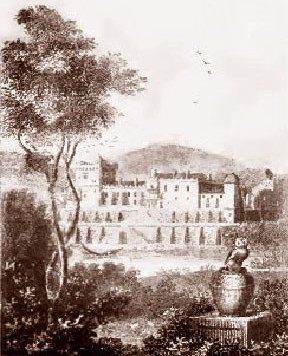
An engraving of the old Skelton Castle, which is classified by the Victoria County History as “imaginative”.
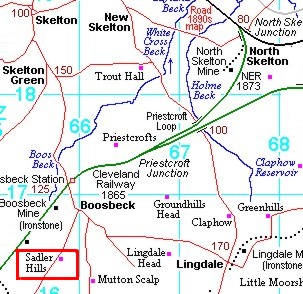
The name still survives.
[Map section taken from “Waggonways in North East England”,
see Introduction for a Link.]
1765
OLD ALL SAINTS CHURCH Plaque in old church of Lord’s Prayer, placed by church wardens., M Smith and C Foster. Moved with other items on rebuilding.
21st June –
BIRTH OF JOHN HALL STEVENSON JUNIOR [WHARTON] – The Birth of John Hall-Stevenson Jr, who changed his name to John Wharton in 1788.
19th November –
ALUM WORKS.
Ralph Jackson’s diary:-
“After breakfast I went to Skelton Castle, drank a ‘Bason’ of Tea there & went out a hunting wth Mr Chaloner & Revd Mr Lascelles till three, upon Hob Hill & by Mr. Hall’s New ‘Allom’ works.”
1769
THE AGE OF STEAM – The steam engine was patented by James Watt.
18th April –
CUSTOMS MAN ASSAULTED.
At the North Riding Quarter Sessions held at Thirsk John Hutchinson of Skelton in Cleveland, a Blacksmith, was convicted of assaulting, beating and abusing William Sisterton, an Officer of the Customs in the execution of his duty. Fined �50 and committed to York Castle, until he be discharged by order of the the Court of Exchequer, pursuant to the statute of the 13th and 14th of King Charles II.
1770
NEW PARSON – New Curate at Skelton All Saints was John Parrington.
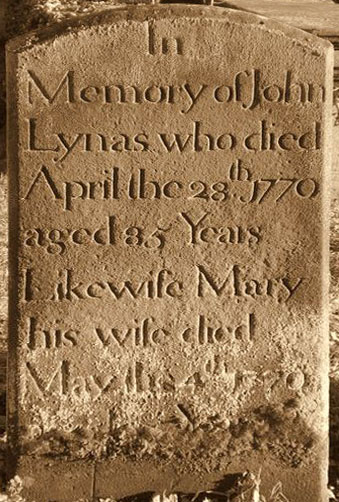
24 November –
SKELTON MURDERER HANGED AND DISSECTED.
William Smith, a Miller, was murdered at night in his bed at home in Skelton in Cleveland by Luke Atkinson who also lived in the village.
On Sunday evening he told Mr Wharton that he had without the least provocation for 3 weeks before the perpetration of the murder several times a strong inclination to commit it;
but had always got the cruel thought driven from his mind, till the unhappy night in which he effected it, when he went to bed, but could not rest;
that he arose from out of his bed and fell to prayer, in hopes of diverting these thoughts;
but so irresistible was the impulse, that he at last went to the house of William Smith armed with a mattock and hatchet, broke open the door with the mattock, and found him asleep in bed,
where he struck him several times on the head, but whether with the mattock or hatchet he did not remember;
and that afterwards he took the deceased’s purse containing one half guinea, a quarter guinea, about five shillings in silver and sixpence in copper.
He declared that his wife was ignorant of the murder and died penitently.
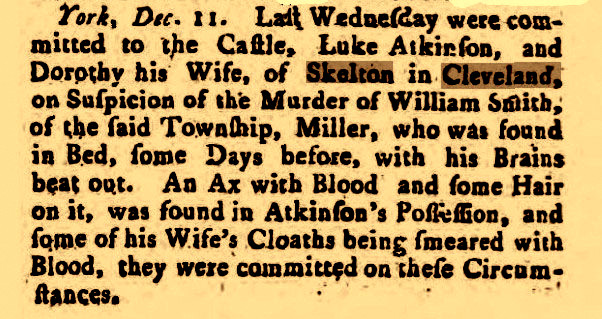

“Murder most foul.”
1771
18 March –
EXECUTION – Luke Atkinson of Skelton was convicted of the murder of William Smith at York Assizes.
He was executed at the York Tyburn without Micklegate Bar and his body sent to the hospital for dissection.
November –
HEAVY FLOODS – Heavy floods in the Tees area washed away bridges etc.
JOHN HALL-STEVENSON.
It was during these years when John Hall Stevenson held reported wild parties at Skelton Castle.
He was not attracted to the usual field-sport pastimes of the landed gentry and seems to have been a rather self-centred wimp.
He had collected a library of Rabelaisian type, mildly obscene literature.
He attempted to write in the same manner himself, but his self-estimation was greater than his works, parts of which, it was said, seem little better than ‘banal smut’.
He occasionally visited London and made the acquaintance of John Wilkes [of satirical and freedom-of-the-Press fame].
Three letters sent in 1762 and written in a familiar tone from him to Wilkes survive.
He also claimed a friendship with Horace Walpole and Rousseau.
In 1760 he published �Lyric Epistle� dedicated to his friend Laurence Sterne on the success of his book �Tristram Shandy� and his reception in London.
Stevenson’s offering included two lyric epistles,
�To my Cousin Shandy on his coming to Town’ and
�To the Grown Gentlewomen the Misses of ****� .
The poet, Thomas Gray, deemed them to be �absolute nonsense�.
There followed �Fables for Grown Gentlemen� in 1761 and �Crazy Tales� in 1762.
These two works are about the meetings of the Demoniacs at Skelton Castle and had some popularity, as second and third reprints were made.
His friend, Horace Walpole, judged Stevenson to possess- “a vast deal of original humour and wit”.
The poet and author, Tobias Smollett in his Critical Review trashed the books.
Stevenson responded with abuse for Smollett and his associates in
‘A Nosegay and a Simile for the Reviewers’ and
‘Two Lyrical Epistles, or Margery, the Cook Maid, to the Critical Reviewers.’

1718 – 1785.
Painted in 1740 by Philipe Mercier
Hall-Stevenson’s ‘A Sentimental Dialogue between two Souls in the palpable Bodies of an English Lady of Quality and an Irish Gentleman” in 1768 was seen as a parody of his friend Sterne’s Tristram Shandy.
Hall-Stevenson also wrote satirically on politics.
He denounced all politicians, with ‘Pastoral Cordial; or an Anodyne Sermon, preached before their Graces Newcastle and Devonshire’ in 1763.
‘A Pastoral Puke; a second Sermon preached before the people called Whigs; by an Independent’ in 1764. ‘Makarony Fables, with the new Fable of the Bees’ in 1787.
‘Lyric Consolations, with the Speech of Alderman Wilkes delivered in a Dream’in 1768.
‘An Essay upon the King’s Friends’ in 1776.Hall-Stevenson gathered round him a circle of reputedly “gay squires and clerics” who called themselves the “Demoniacs”.
Skelton Castle for a time became the venue for boisterous and, for that time, erotic parties with much over-eating and drinking.
It was said – “He kept a full-spread board,and wore down the steps of his cellar.”
Among the “demoniacs” was an irreverent Reverend, Robert Lascelles, who through the patronage of Hall-Stevenson later became the Vicar of Gilling near Richmond.
He was nicknamed Pantagruel or Panty.
Another was one Zachary Moore of nearby Lofthouse, who inherited wealth from his family’s ownership of alum mines.
It was said he shod his horses with silver shoes and spent his life in riotous living with noble friends, who “assisted him in the laborious work of getting to the far end of a great fortune.”
Zachary sold the Loftus family estate of the Steward-Moores to the Dundas family of Marske Hall [later Lord Zetland] and ended up in comparative poverty in a minor post in Gibraltar, arranged by one of his friends.
Other Demoniacs were Hall-Stevenson�s brother, Colonel Hall, a Colonel Lee, an architect named Pringle, and a schoolmaster, Andrew Irvine of Kirkleatham.
David Garrick, the actor is said to have been among the occasional guests.
‘Crazy Tales’ is about the parties at Skelton Castle and puts into the mouth of each Demoniac a more or less obscene story.
It would appear that his sexual wanderings were not confined to his lusty pen.
In his Will he left a pension of £40 per annum and some his personal assets to his housekeeper, one Hannah Wilson “for her good services” as long as she did not marry, in which case it would be halved.
And £1,000, an enormous sum in those days, to his seemingly bastard son:-
I do hereby charge, order and direct my said brother� to purchase a convenient dwelling-house in some part of the said county of York and let it the said Hannah Wilson for and during her natural life.
With remainder to her natural or reputed son, John Wilson, his heirs and assigns for ever; provided nevertheless that the purchase money…..shall not exceed two hundred pounds nor be less than one hundred and fifty pounds British money. Also I give and bequeath the sum of one thousand pounds of like money to the said John Wilson.”

1713 to 1768.
LAURENCE STERNE.
The most famous visitor, of course, was Sterne himself.
He became in 1738 the clergyman for Sutton in the Forest, 8 miles from York, and he also had duties at York Minster.
Despite this he had a reputation as a lady’s man and made frequent visits to his old friend at Skelton and joined in the revelries.
John Hall Stevenson had many eccentricities and used to take to his bed whenever the cold east wind blew off the sea, which in Skelton is often.
It is said that Sterne, to fool his friend into activity, was in the habit of paying the stable boy to climb to the weather cock and fasten it in a south westerly direction.
Among their pastimes was “chariot racing”, when they competed in their chaises along the several mile stretch of flat sand between Saltburn and Redcar.
The character Eugenius in Sterne’s Tristram Shandy is supposedly based on Stevenson.
A hundred years after Sterne’s death, Skelton still held his memory, an area near the wood above Skelton Mill being called ‘Sterne’s Seat’ and the wood behind is ‘Mount Shandy’.
Did Sterne obtain his hero’s name from the wood or was the wood called after the book or is there any connection at all.
A.E Pease in his book “The Cleveland Hounds” appeared to think so:-
“Mount Shandy, called so from the fact that Sterne, who was a frequent visitor at Skelton Castle, wrote Tristram Shandy in the woods about this hill.”
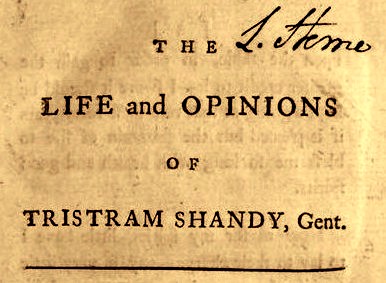
[Laurence Sterne’s remains now rest against the South wall of St. Michaels Church in Coxwold, N. Yorkshire, where he served as vicar.
But they arrived there by a strange route.
He died in London and was originally interred at St. George’s in Hanover Square. His corpse was dug up by the “bodysnatchers” who earned money selling their wares for anatomical lectures.
It is said that someone recognised Sterne and his body was hastily returned to St. George’s.
In 1969 St George’s churchyard was going to be “developed” and the Laurence Sterne trust transferred his remains along with the original headstone to St Michaels, Coxwold.]
The following lines which were on the front of a spring which supplied the castle were most probably Stevenson’s –
Leap from thy mossy cavern’d bed,
Hither thy prattling waters bring
Blandusia’s Muse shall crown thy head
And make thee too a sacred spring
Sadly, no one has ever found a picture of old Skelton Castle, which was pulled down and rebuilt at the end of the eighteenth century.
Some have suggested that the illustration for the frontispiece of Stevenson’s “Crazy Tales” is a true representation of it.
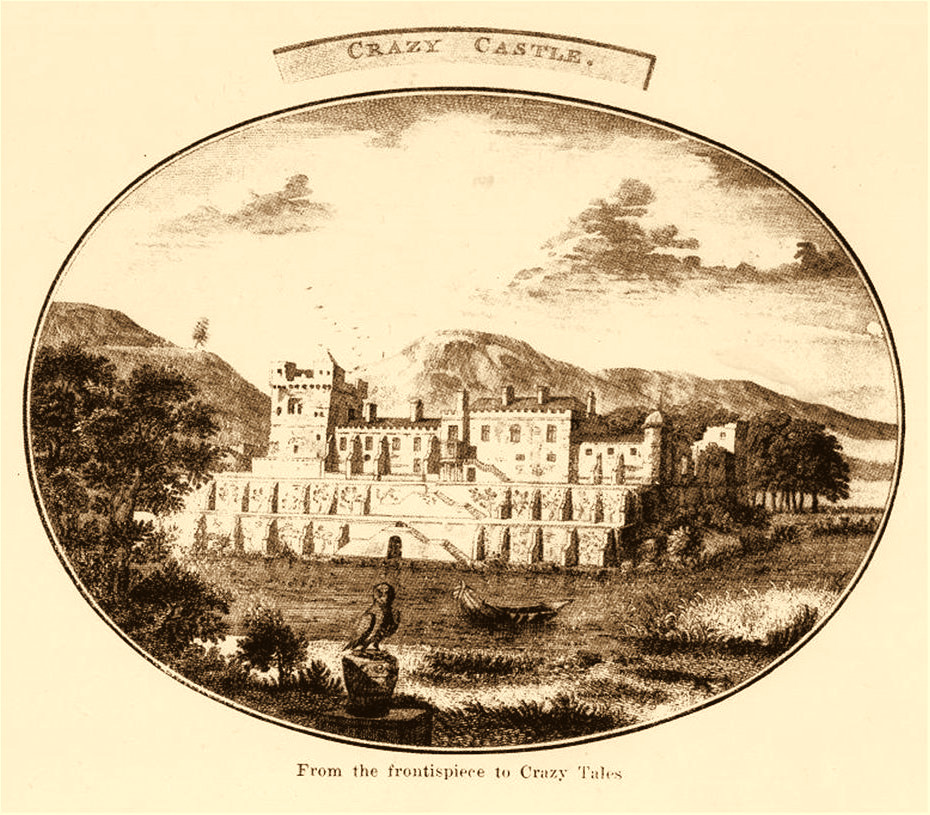
Illustration from “Crazy Tales”
The drawing made by Samuel Buck in the 1720’s suggests that it was similar. However, it looks like no other Norman castle and, like the surrounding scenery, some features could be the creation of the illustrator’s imagination in line with the title of the book.
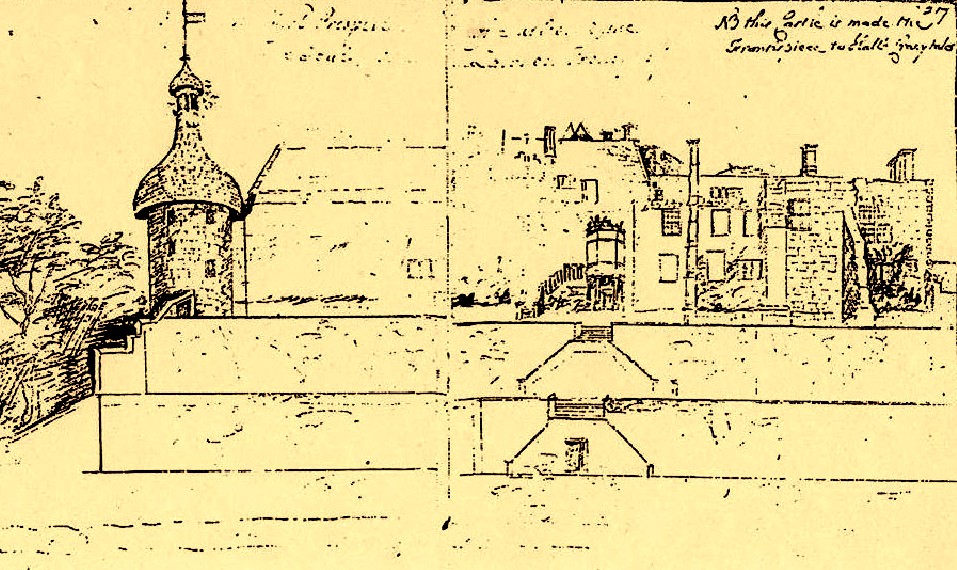
[This image and the painting of John Hall Stevenson below have been kindly contributed by Dr Tony Nicholson, Lecturer in History at Teesside University.]
The map of 1773, which follows, proves that there was no moat at this time in front of the Castle. Hall-Stevenson considered major restoration work to Skelton Castle, but did not have the funds for such a massive project and was warned against it by Sterne –
“But what art thou meditating with axes and hammers ?
It may be very wise to do this � but ’tis wiser to keep one’s money in one’s pocket, whilst there are wars without and rumours of wars within.”
On the other hand another of Sterne’s letters, written on the 4th of September 1764, shows that Hall-Stevenson was by no means totally short of funds and that the source was the local production of alum:-
“If you can get to Scarborough, do – a man who makes six tons of alum a week may do anything”.
In about the year 1765 Hall-Stevenson had re-opened the alum workings at Selby Hagg, close by Hagg Farm and the Alum House near Cat Nab, Saltburn.
The alum liquor flowed between the two places in a trough that followed the course of Millholme Beck. The enterprise was sold around 1777.

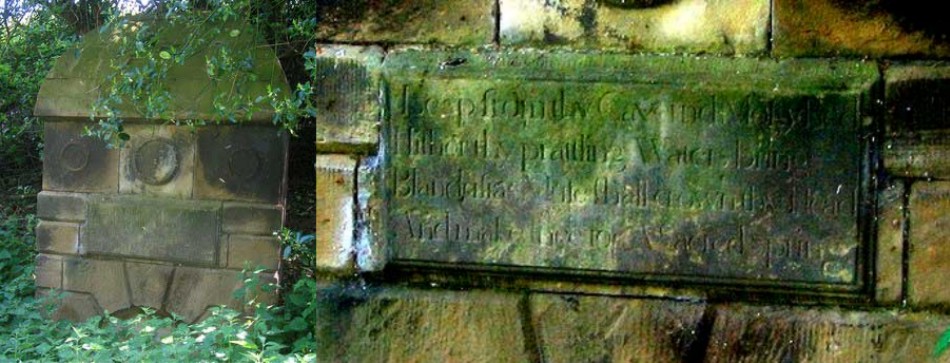
Sterne’s Well.
It has been called a Well. but the water supply was actually a spring of pure water, which no doubt supplied the Castle and local people and had done for centuries.
This natural provision of clear pure drinking water is the most likely reason why people settled here originally.
At some later date the water outlet was moved to a trough some yards away by the roadside, the remains of which still stand.
I remember filling a bucket there myself in the early 1950’s when, for some reason, the mains were switched off.
The spring still flows today and has been diverted to a pipe that allows the water to run into the stream at the right.
This stream flows down by the side of the Castle, and in times gone by was dammed to form the moat.
The water then went via a sluice gate at the back of the Castle to a pool which worked Skelton Mill and thence to Skelton Beck and the North Sea.
[The collage has been made from photographs kindly contributed by Chris Twigg of the “Hidden Teesside” website. Click here to visit. ]
The following lines by Hall-Stevenson are said to describe the condition of Skelton Castle at the time.
There is a castle in the north
Seated upon a swampy clay,
At present but of little worth
In latter times it had its day.
This ancient castle is called CRAZY,
Whose mouldering walls a moat environs,
Which moat goes heavily and lazy,
…A turret also you may note
Its glory vanished like a dream
Transform’d into a pigeon cote
Nodding beside the sleepy stream
From whence, by steps with moss o’ergrown
You mount upon a terrace high,
Where stands that heavy pile of stone
Irregular and all awry.
If many a buttress did not reach
A kind and salutary hand
Did not encourage and beseech
The terrace and the house to stand,
Left to themselves and at a loss
They’d tumble down into the foss.
Over the castle stands a tower,
Threatening destruction every hour….

[Photograph kindly contributed by Brian Hudson, Professor of Urban Development, Brisbane, Australia, a native of Skelton.]

showing Sterne’s Seat and Mount Shandy

Plaque in Skelton Old Church
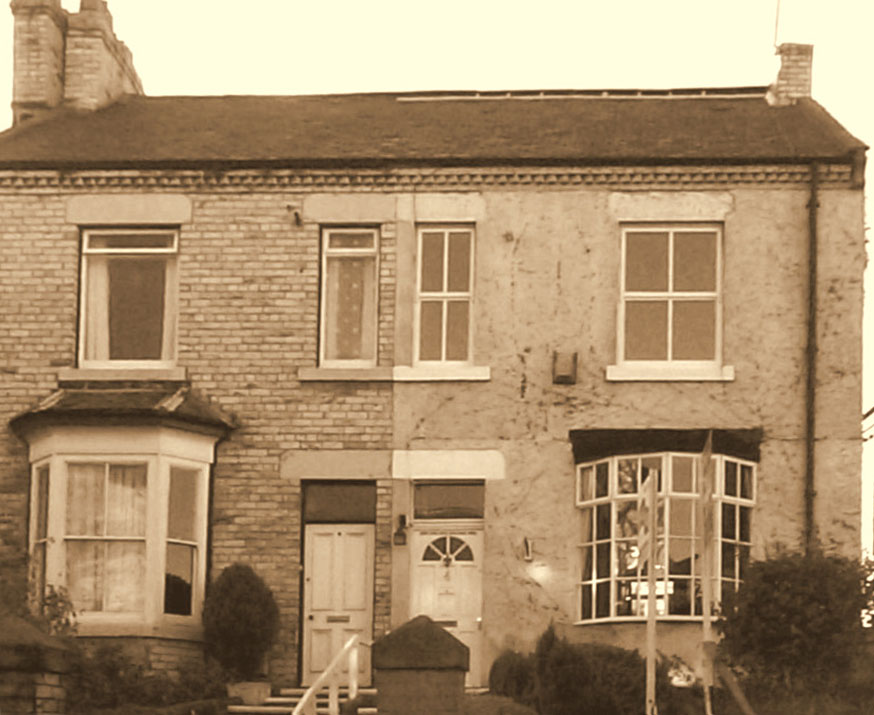
4 and 6 Green Rd – Skelton Mawer’s Charity School.
1773
WILL OF THOMAS MAWER.
The sum of 20 pounds [worth �1.500 in year 2002 values] was left by a Thomas Mawer for the education of 4 poor children from Skelton and nos 4 and 6 Green Road was bought for this purpose for �30 10s 6d. A section of the deeds reads:-
“Reciting the Will dated 5th October 1755 of Thomas Mawer whereby after sundry specific bequests he gave and devised unto Quesiphorous Hoops and William Harrison all such sums of money he then had out at an intt upon any mtges bojds etc and all his ready monies debts goods, cattle chattels and psnl est whatsoever. In trust amongst other things to pay the sum of �20….. into the hands of the Minister and 4 or more of the principal inhabitants of Skelton afore said to be by them placed out at intt upon such security as they or the major pt of them should approve of and such interest to be applied and given to sm. Schoolmaster or Schoolmistress for teaching such and so many poor children as the said Minister and inhabitants think fit.”
MAP OF SKELTON ESTATE IN 1773.
A map of Skelton Estate in 1773 is shown on the next page.
It has been sent by John Dobson, an old Skeltoner and now living in N Walsham, Norfolk. [Redrawn, as the original is hard to show as a webpage.

Front of a Map of Skelton Estate dated 1773.
This image kindly contributed by Dr Tony Nicholson of Brotton.
The purpose appears to have been purely a record of the land owned by Hall Stevenson of Skelton Castle.
The illustration on the Front of “Crazy Tales”, published 1762, which was taken from the engraving above has often been thought to show what the Castle looked like at this time.
This map clearly shows that there was no moat in 1773.
Half of the Castle is covered by woodland. The entrance road runs past the old All Saints Church directly into the Castle and the outline of the Castle on the map shows the building juts out on the Left of the facade.
A moat existed at either side of the Castle after 1785, when John Wharton had it rebuilt. The pear-shape of the grounds of the Old Church stands out and this feature is generally taken to indicate a History dating back to the very earliest Anglo-Saxon Christian times.
The roads then would have been unmetalled cart tracks and some like Boroughgate Lane, Stackgarth Lane are now just footpaths.
Next Page – Skelton Map 1773.
Previous Page – 1748 TO 1755.
Contents Page.